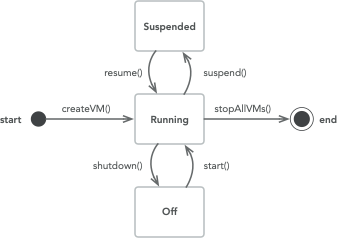Interacting with a cloud compute service
A cloud service provides mechanisms to manage the set of VMs instantiated on hardware resources. Each VM instance, while it’s running, exposes its own bare-metal compute service to which standard jobs can be submitted. As a result, one never submits a job directly to a cloud service.
It is possible to create, shutdown, start, suspend, and resume VMs (see
a complete list of functions available in the
wrench::CloudComputeService API documentation). The figure below
shows the state transition diagram of a VM instance:

Here is an example interaction with a wrench::CloudComputeService:
std:shared_ptr<wrench::CloudComputeService> some_cloud_cs;
// Create a VM with 2 cores and 1 GiB of RAM, which could fail if
// not enough resources are available
auto vm1_name = some_cloud_cs->createVM(2, pow(2,30));
// Create a VM with 4 cores and 2 GiB of RAM, which could fail if
// not enough resources are available
auto vm2_name = some_cloud_cs->createVM(4, pow(2,31));
// Start both VMs and keep track of their associated bare-metal compute services
auto vm1_cs = some_cloud_cs->startVM(vm1_name);
auto vm2_cs = some_cloud_cs->startVM(vm2_name);
// Create a job manager
auto job_manager = this->createJobManager();
// Create a job
auto job = job_manager->createStandardJob({... some tasks ...});
// Submit the job to the 1st VM (i.e., to its bare-metal compute service)
job_manager->submitJob(job, vm1_cs);
// Sleep for 10 seconds
Simulation::sleep(10);
// Suspend the 1st VM
some_cloud_cs->suspendVM(vm1_name);
// Sleep for 10 seconds
Simulation::sleep(10);
// Resume the 1st VM
some_cloud_cs->resumeVM(vm1_name);
// Wait for and process the next event (should be a standard job completion or failure)
this->waitForAndProcessNextEvent();
// Shutdown both VMs
some_cloud_cs->shutdownVM(vm1_name);
some_cloud_cs->shutdownVM(vm2_name);
// Destroy both VMs, which releases resources
some_cloud_cs->destroyVM(vm1_name);
some_cloud_cs->destroyVM(vm2_name);
Note that the cloud service will decide on which physical resources VM instances should be created. The underlying physical resources are completely hidden by the cloud service abstraction. If you want more control over how the physical resources are used you likely need a virtualized cluster services.
See the execution controller implementation in
examples/workflow_api/basic-examples/cloud-bag-of-tasks/TwoTasksAtATimeCloudWMS.cpp
for a more complete example.